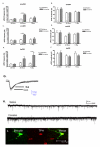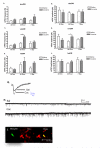Dorsal raphe 5-HT(2C) receptor and GABA networks regulate anxiety produced by cocaine withdrawal
- PMID: 25656481
- PMCID: PMC4387096
- DOI: 10.1016/j.neuropharm.2015.01.021
Dorsal raphe 5-HT(2C) receptor and GABA networks regulate anxiety produced by cocaine withdrawal
Abstract
The serotonin system is intimately linked to both the mediation of anxiety and long-term effects of cocaine, potentially through interaction of inhibitory 5-HT2C receptor and gamma-aminobutyric acid (GABA) networks. This study characterized the function of the dorsal raphe (DR) 5-HT2C receptor and GABA network in anxiety produced by chronic cocaine withdrawal. C57BL/6 mice were injected with saline or cocaine (15 mg/kg) 3 times daily for 10 days, and tested on the elevated plus maze 30 min, 25 h, or 7 days after the last injection. Cocaine-withdrawn mice showed heightened anxiety-like behavior at 25 h of withdrawal, as compared to saline controls. Anxiety-like behavior was not different when mice were tested 30 min or 7 days after the last cocaine injection. Electrophysiology data revealed that serotonin cells from cocaine-withdrawn mice exhibited increased GABA inhibitory postsynaptic currents (IPSCs) in specific DR subregions dependent on withdrawal time (25 h or 7 d), an effect that was absent in cells from non-withdrawn mice (30 min after the last cocaine injection). Increased IPSC activity was restored to baseline levels following bath application of the 5-HT2C receptor antagonist, SB 242084. In a separate cohort of cocaine-injected mice at 25 h of withdrawal, both global and intra-DR blockade of 5-HT2C receptors prior to elevated plus maze testing attenuated anxiety-like behavior. This study demonstrates that DR 5-HT2C receptor blockade prevents anxiety-like behavior produced by cocaine withdrawal, potentially through attenuation of heightened GABA activity, supporting a role for the 5-HT2C receptor in mediating anxiety produced by cocaine withdrawal.
Keywords: Addiction; Anxiety; Cocaine; Electrophysiology; GABA; Serotonin.
Copyright © 2015 Elsevier Ltd. All rights reserved.
Figures







Similar articles
-
Effects of cocaine history on postsynaptic GABA receptors on dorsal raphe serotonin neurons in a stress-induced relapse model in rats.Eur Neuropsychopharmacol. 2016 Jan;26(1):45-54. doi: 10.1016/j.euroneuro.2015.11.009. Epub 2015 Nov 21. Eur Neuropsychopharmacol. 2016. PMID: 26640169 Free PMC article.
-
Selective 5-HT receptor inhibition of glutamatergic and GABAergic synaptic activity in the rat dorsal and median raphe.Eur J Neurosci. 2006 Dec;24(12):3415-30. doi: 10.1111/j.1460-9568.2006.05222.x. Eur J Neurosci. 2006. PMID: 17229091 Free PMC article.
-
Modulation of GABA release from the thalamic reticular nucleus by cocaine and caffeine: role of serotonin receptors.J Neurochem. 2016 Feb;136(3):526-35. doi: 10.1111/jnc.13398. Epub 2015 Nov 12. J Neurochem. 2016. PMID: 26484945 Free PMC article.
-
Serotonin2C receptors and drug addiction: focus on cocaine.Exp Brain Res. 2013 Oct;230(4):537-45. doi: 10.1007/s00221-013-3593-2. Epub 2013 Jun 8. Exp Brain Res. 2013. PMID: 23748692 Review.
-
Serotonin 5-HT2 receptor interactions with dopamine function: implications for therapeutics in cocaine use disorder.Pharmacol Rev. 2015;67(1):176-97. doi: 10.1124/pr.114.009514. Pharmacol Rev. 2015. PMID: 25505168 Free PMC article. Review.
Cited by
-
Divergent modulation of pain and anxiety by GABAergic neurons in the ventrolateral periaqueductal gray and dorsal raphe.Neuropsychopharmacology. 2023 Sep;48(10):1509-1519. doi: 10.1038/s41386-022-01520-0. Epub 2022 Dec 16. Neuropsychopharmacology. 2023. PMID: 36526697 Free PMC article.
-
Differential behavioral and molecular alterations upon protracted abstinence from cocaine versus morphine, nicotine, THC and alcohol.Addict Biol. 2017 Sep;22(5):1205-1217. doi: 10.1111/adb.12405. Epub 2016 Apr 28. Addict Biol. 2017. PMID: 27126842 Free PMC article.
-
Brain systems in cocaine abstinence-induced anxiety-like behavior in rodents: A review.Addict Neurosci. 2022 Jun;2:100012. doi: 10.1016/j.addicn.2022.100012. Epub 2022 Mar 20. Addict Neurosci. 2022. PMID: 37485439 Free PMC article.
-
Efficacy of Olanzapine in Anxiety Dimension of Schizophrenia: A Systematic Review of Randomized Controlled Trials.Clin Psychopharmacol Neurosci. 2022 Nov 30;20(4):592-599. doi: 10.9758/cpn.2022.20.4.592. Clin Psychopharmacol Neurosci. 2022. PMID: 36263635 Free PMC article. Review.
-
Effects of Alcohol and Cocaine in a Mutant Mouse Model of Predisposition to Post-Traumatic Stress Disorder.Front Pharmacol. 2020 May 8;11:623. doi: 10.3389/fphar.2020.00623. eCollection 2020. Front Pharmacol. 2020. PMID: 32477119 Free PMC article.
References
-
- Azmitia EC, Segal M. An autoradiographic analysis of the differential ascending projections of the dorsal and median raphe nuclei in the rat. J. Comp. Neurol. 1978;179:641–647. - PubMed
-
- Basso AM, Spina M, Rivier J, Vale W, Koob GF. Corticotropin-releasing factor antagonist attenuates the “anxiogenic-like” effect in the defensive burying paradigm but not in the elevated plus-maze following chronic cocaine in rats. Psychopharmacol. (Berl) 1999;145:21–30. - PubMed
Publication types
MeSH terms
Substances
Grants and funding
LinkOut - more resources
Full Text Sources
Other Literature Sources
Medical

